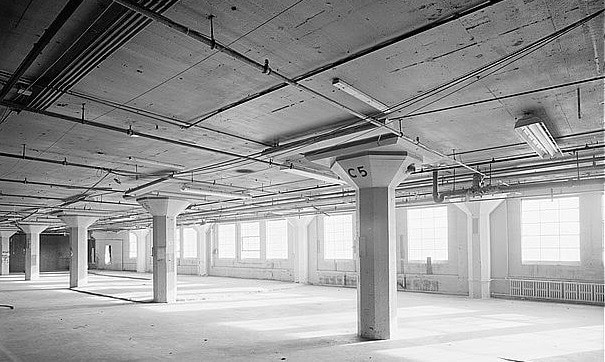Flat Slab

Description
This is the simplest and most widely spread cast in situ slab system. It usually includes 2 layers of reinforcement meshes, one near the top and one near the bottom. Thus, the force flow in the slab can go in two directions, which makes it more efficient for square floor layouts. In some rare instances, flat concrete slabs can be post tensioned. However, there are generally more efficient slabs for spans in which prestressing is required. As for most cast in situ slabs, it is beneficial to have a continuous slab in order to drastically decrease deformations. A flat concrete slab is economical for spans up to 10 m, afterwards ribbed slabs and waffle slabs take its spot because self-weight starts playing a bigger role.
A flat concrete slab usually has a fire resistance of 90 minutes but as for all non-prefab floors, it must be verified using the codes. Punching shear often is the biggest issue.
The flexibility is one of its biggest strengths, as it can have any shape and is able to adapt to spontaneous changes on site. Building systems can also be integrated in the slabs. The complexity is dependent on the shape and the amount of building systems included in the slab, so it should not be underestimated. The construction takes a lot of time because of the required formwork and the curing time of the concrete.
As in most concrete floors, vibration is not a concern due to the large weight.
For a square slab, the slenderness ration l/h lays around 25, but is dependent on the amount of reinforcement included.
Database
Floor type |
Flat Slab |
||
|---|---|---|---|
Materials |
concrete cast in situ_reinforcing steel_posttensioning possible |
||
Description |
The normal one |
||
Way of carrying |
Does the main span carry in one or two directions? |
two way slab |
|
Span width low [m] |
Economically possible |
0 |
|
Span width high [m] |
Economically possible |
10 |
|
Additional measures when installing |
formwork_propping up |
||
Prefab? |
Is prefab possible? |
no |
|
Continous slab? |
Can you build the slab with supports in middle of the slab? |
yes |
|
Building systems integratable? |
Can buildings systems be included into the slab itself? |
yes |
|
Fire |
Fireresistance without costly measures [min] |
90 |
|
Substructure |
Certain prerequisites necessary? |
no |
|
Prone to vibration |
no |
||
Environment |
General classification including formwork |
1 to 5 terrible to very good |
2 |
Construction time |
Time on site |
1 to 5 very slow to very fast |
2 |
Flexibility |
Average of the next two |
1 to 5 |
5 |
Flexibility on site |
How flexible is the system to spontaneous changes on site? |
1 to 5 terrible to very good |
5 |
Flexibility geometry |
How good can you adapt the slab to complex geometries? |
1 to 5 not at all to very easy |
5 |
Complexity |
Average of the next two |
1 to 5 |
3 |
Complexity fabrication |
Complexity of floor itself. |
1 to 5 very complicated to very simple |
3 |
Complexity installation |
Complexity installation on site |
1 to 5 very complicated to very simple |
3 |
Slenderness l/h 3kPa |
Applied load (without selfweight) |
Residential building |
25 |
Slenderness l/h 4kPa |
Applied load (without selfweight) |
Office building |
25 |
Weight [kN/m3] |
per m2 and total height of slab |
25 |
|
Embodied energy [MJ/m3] |
per m2 and total height of slab |
5948 |
References
- General information:
Goodchild, C., Webster, R., & Elliott, K. (2009). Economic Concrete Fram Elements to Eurocode 2. Camberley UK: The Concrete Centre.
Cement and Concrete Association of Australia. (2003). Guide to Long-Span Concrete Floors. Sydney.
Lecture Stahlbeton I/II/III. ETH Zürich.- Span width:
0 - 12m (Goodchild, C., Webster, R., & Elliott, K. (2009). Economic Concrete Fram Elements to Eurocode 2. Camberley UK: The Concrete Centre.)
0 - 9m (Cement and Concrete Association of Australia. (2003). Guide to Long-Span Concrete Floors. Sydney.)- Fire resistance:
60min (Goodchild, C., Webster, R., & Elliott, K. (2009). Economic Concrete Fram Elements to Eurocode 2. Camberley UK: The Concrete Centre.)
90min (https://www.researchgate.net/publication/257809259_Structural_Performance_of_Reinforced_Concrete_Flat_Plate_Buildings_Subjected_to_Fire)
90min (https://ijcsm.springeropen.com/articles/10.1007/s40069-012-0011-2)- Slenderness:
l/h=28 for 3kPa, l/h=25 for 4kPa (Goodchild, C., Webster, R., & Elliott, K. (2009). Economic Concrete Fram Elements to Eurocode 2. Camberley UK: The Concrete Centre.)
l/h=25 for 3kPa, l/h=25 for 4kPa (Lecture Stahlbeton I ETH Zurich)- Weight:
Swiss Code SIA 261
- Embodied energy:
- Photo Source:
http://tucepindia.blogspot.com/2014/10/flat-slab-floor-system.html